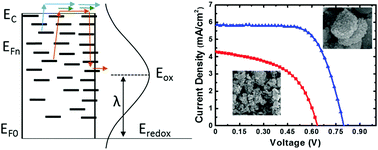Control of morphology and defect density in zinc oxide for improved dye-sensitized solar cells†
Abstract
While zinc oxide (ZnO) with a mesoporous network has long been explored for adsorption of dyes and as an electron-transporting medium in dye-sensitized solar cells (DSSCs), the performance of ZnO-based DSSCs remains unsatisfactory. Despite the importance of understanding the surface characteristics of ZnO in DSSC applications, most of the studies relevant to ZnO-based DSSCs are focused on the synthesis of unique nanostructures of ZnO. In this study, we not only introduce a novel disk-shaped ZnO nanostructure, but also provide insight into the distinctive surface properties of ZnO and its influence on DSSC performance. When utilized in DSSCs, the mesoporous ZnO nanodisk yields 60% better power conversion efficiency (PCE) compared to commercial ZnO nanoparticles, which is attributed to less surface and bulk trap densities as concluded by an in-depth open-circuit voltage decay (OCVD) analysis and electrochemical impedance spectroscopy (EIS). Another aspect that contributes to the higher PCE is the better connectivity of primary particles that join together to form secondary disk-shaped particles. Furthermore, a 40% improvement in the PCE was observed by coating the mesoporous ZnO nanodisk with TiO2, which results from the passivation of the surface defects that aid in suppressing the interfacial charge recombination.


 Please wait while we load your content...
Please wait while we load your content...